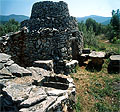|
3 Bunja,
trim, Dalmatia, Hvar; Croatia
The stone object from Zadar, over Šibenik to the island
of Brac is named bunja. Typical bunja has stepped roof
with gravel on the top surface. Mostly it is incorporated
into the walls.
Inner construction is typical corbelling, shelters are outside
very different.
Very important composition can be found on the island of Žirje
(in front of Šibenik), where two or three units are composed
together. In the area can be found 'Šuplja gromila', small
rectangular shelter incorporated into the bigger wall. Similarity
to the objects alike (in Puglia, in Caucasus) shows the possible
age: the same objects in Italy are dated back to 3rd and 7th
century AD, in Caucasus to 13th.
Trim is stone shelter on the island of Hvar.
The island is very poor on the fertile soil, and every part
of the field could be solved with hard work: dry stone walling.
There is no soil and no water too: but the rain can be catch
into the cisterns. Trim and cisterns are the most common element
of the architecture on the island.
Between the fields (lavender) or vineyards on the plain, stone
walls are in use as runways.
Construction is mostly circular, with stepped roofs. Staircases
and ramps are very often, because roofs were in use for drying
the fruit.
A lot of details are on Hvar very important for vernacular
architecture: niches, entrances, windows, slings, wells and
the most important detail: discharging elements above the
lintel are typical for trim.

|

| bunja
near Sibenik (Dalmatia) 1999 |
|

| bunja
North of Sibenik (Dalmatia) 1999 |
|

| bunja
North of Sibenik (Dalmatia) 1999 |
|

| bunja,
not far from Sibenik (Dalmatia) 1999 |
|

| bunja
in the island of Zirje, near Sibenik, 1999 |
|

| trim
on the island of Hvar (2oo4) |
|

| trim
high on the plateau of the island of Hvar (2oo4) |
|

| trim
near Stari Grad, island of Hvar (2oo4) |
|
Click
to enlarge!
|